Then cloud gaming comes to the rescue. With services like Sony PlayStation Now, Google Stadia and GeForce NOW, more and more modern game titles are becoming available to the average PC and mobile user. At the same time, the field is only planning to expand, and Microsoft, Electronic Arts, Nintendo, Amazon and Tencent have already announced the launch of their cloud gaming platforms.
The PwC team, with the assistance of GFN.RU, a partner of NVIDIA GeForce NOW in Russia and the CIS, conducted a study of the Russian cloud gaming market for the first time, and we provide here its extract.

What is cloud gaming
Cloud gaming is a service that allows you to play video games remotely - that is, without the presence of physical components (hardware) and a local copy of the game for the user.
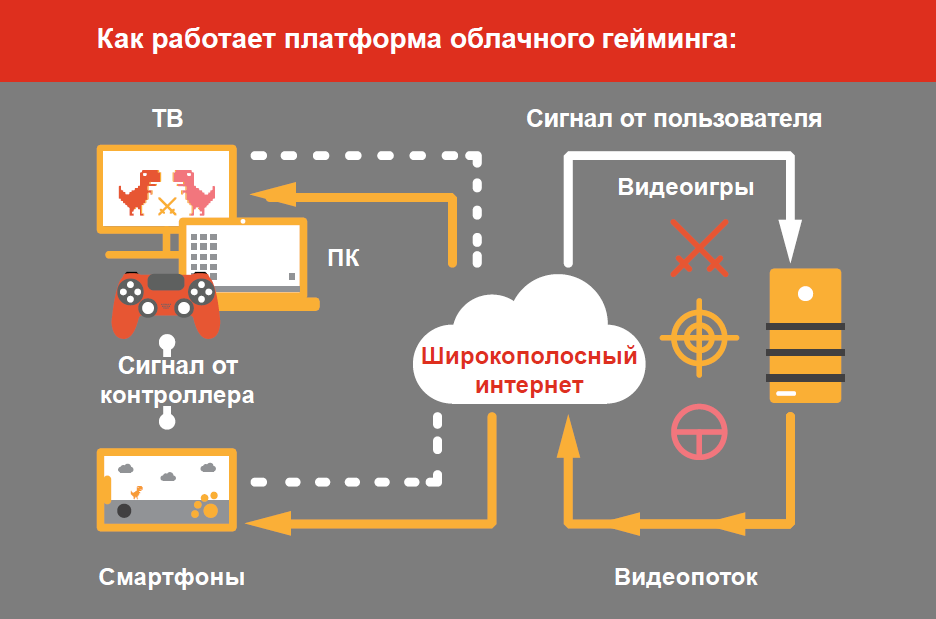
“Cloud” in this case is a server or a network of servers used to store, process and transmit user data and graphics processing of video games. Interaction with the server is carried out through a lightweight client that the player installs on a computer or smartphone.
Prospects for cloud gaming in the world
On average, the video game market is growing by almost 6% every year, and by 2024 its volume is expected to grow to an amount of about $ 174 billion.At

the same time, the global cloud gaming market in 2019 exceeded $ 150 million, and by 2025 it may be from $ 3 000 to $ 6,000 million.
We have already written about the work of cloud services in the USA in one of our previous materials .
The key factors behind the rapid growth of the market are the high popularity of gaming, easy access to games with minimal investment and the deployment of 5G networks around the world. According to experts, there are more than 1 billion personal computer owners in the world who are not ready to launch video games. All of them are potential target audience for cloud gaming. In addition, you do not need to have a PC to run streaming services - this feature is also available to smartphone users.
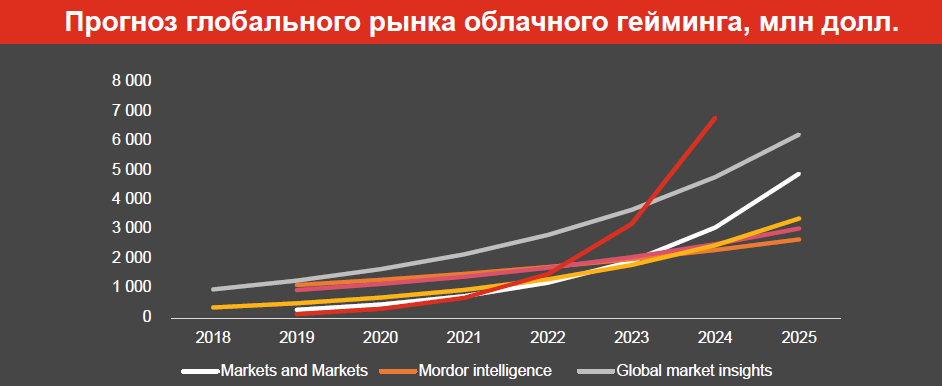
An important factor in the development of the cloud gaming market is the annual rise in the cost of components for gaming computers and the cost of game consoles such as Xbox and PlayStation. The advantage of cloud services (in particular, NVIDIA GeForce NOW) is to provide access to games using the latest graphics technologies such as ray tracing, which are only available on the latest generation graphics cards.
In addition to graphics technologies, new solutions are emerging in the field of data transfer optimization, artificial intelligence and machine learning, the use of which in cloud gaming will improve the quality of services without scaling the computing part.
Moving the computing part to the server side will allow you to create game worlds that are much larger than the current ones, for example, with a battlefield of 1000 per 1000 people. The use of the cloud will also help reduce piracy and cheating, making competitive games more fair and easier to control, including esports.
The potential of the Russian cloud gaming market
According to various estimates, among the Russian population between 30 and 50 million people play video games on various platforms.
The Russian language is one of the three most popular languages on the Steam gaming platform: users from the Russian-speaking segment on the platform are 11% - this number is second only to English and Chinese.
The video game market in Russia is growing annually by an average of 5.1%, which is close to global indicators. The market volume last year was $ 2.1 billion.
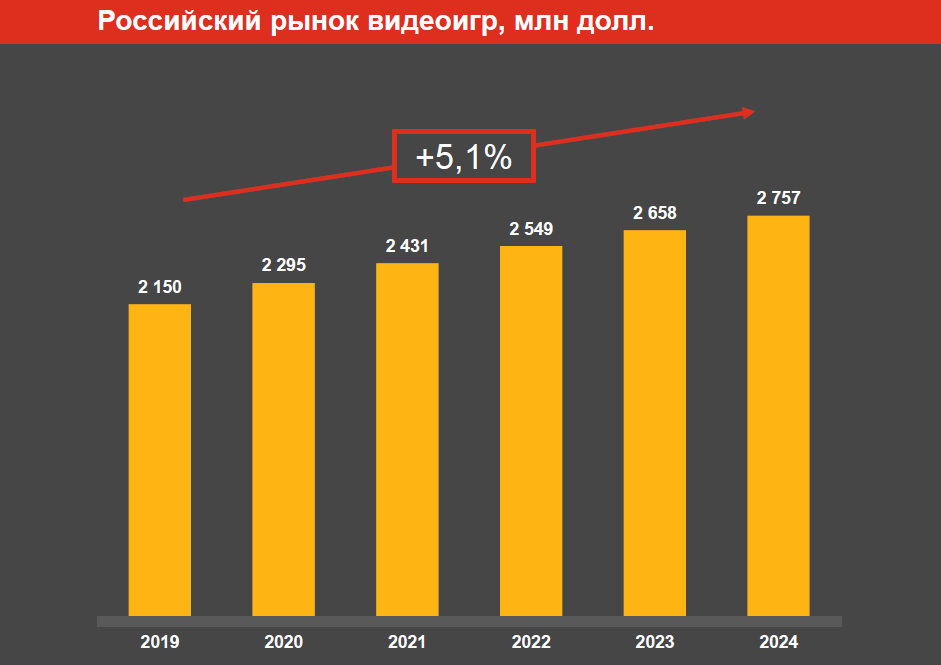
Russian market drivers
The development potential of the cloud gaming market in Russia is associated with the spread of high-speed Internet, the speed and quality of which is among the top ten in the world. As of 2019, more than 40 million of all households in Russia (73.6% of the total) are connected to broadband Internet. Moreover, about 20 million computers are not technically ready to run games.
The issue of the availability of their own gaming platforms for Russian players is especially relevant due to the fact that the growing dollar exchange rate affects the cost of components for personal computers and thereby creates high barriers for a potential audience wishing to purchase or assemble a gaming PC.
The issue of switching to a new generation of 5G mobile communications for Russia is still not relevant, since it is planned to produce it only in 2024. This is hindering the growth of the mobile audience for cloud gaming.
Currently, the following gaming cloud services are presented in Russia: GeForce Now, Playkey, Loudplay, Megadrom, Power Cloud Game, Drova, Beeline Gaming, PlayCloud, PlayInCloud; as well as requiring a console or PC: Project xCloud, PS Remote, Steam Link, Remotr, Parsec, Cloudzen.tech.
Cloud gaming audience
At the moment, users of cloud gaming services are those players who follow the latest technological trends and are not afraid to try out new services among the first.
The information below is provided by the GFN.RU service and applies only to its audience, and therefore may differ from other platforms.
Geography of gamers
At the time of publication of this study, the total number of registered users on the GFN.RU website was 1,263,155. Since the launch of the GFN.RU service in October 2019, a total of 328,934,757 minutes have been played, or 626 years of game time.
Game rating by number of players
Based on the number of users, Fortnite is the most popular game on the service: 80,000 people have launched the game at least once using GFN.RU. It is followed by Counter Strike GO (50,000 users), The Witcher 3 (37,000 users), World of Tanks (36,000 users), Rust (25,000 users).
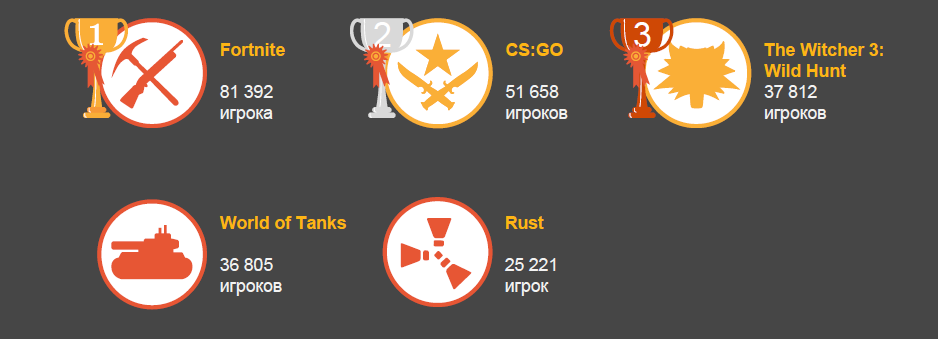
Rating of games by gaming sessions
If we take the number of gaming sessions as a criterion, Fortnite remains the leader with 700,000 game sessions, Rust is in second place with 650,000 sessions, then Counter-Strike: Global Offensive (360,000 sessions), The Witcher 3: Wild Hunt ( 340,000 sessions), Apex Legends (340,000 sessions).
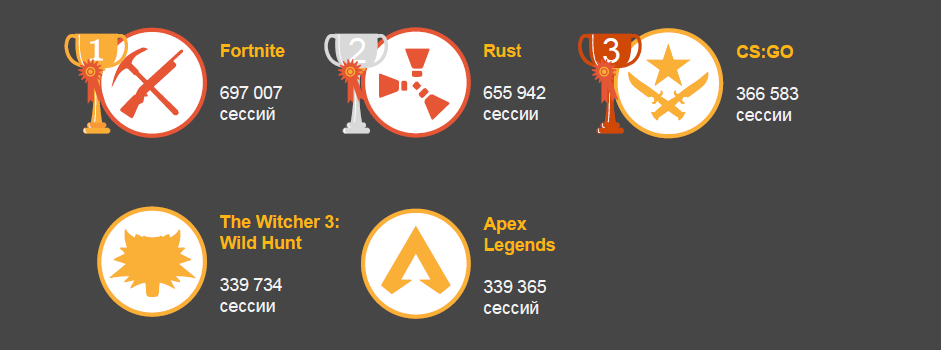
Rating of games by time spent in the game
In Rust, users of the service spent 42 million minutes, in Fortnite - 24 million minutes, in The Witcher 3 - 20 million minutes, in Dota 2 - 15 million minutes, in Apex Legends - 14 million minutes.
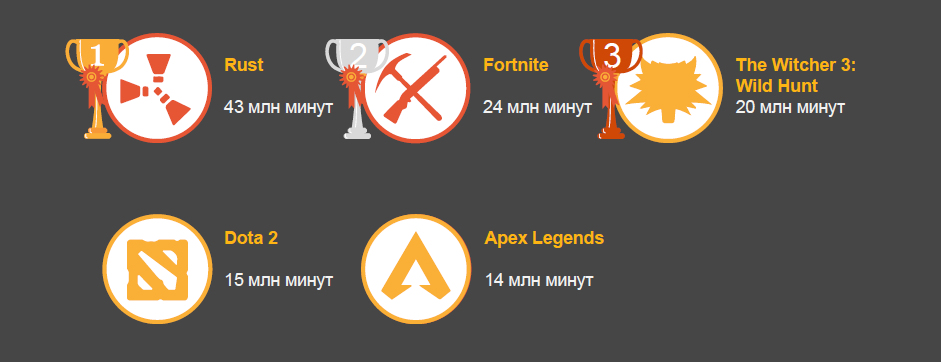
City rating
The leader in the number of GFN.RU clients among Russian cities is Moscow with 51,329 players (or 1,065,196 sessions and 5.3 million minutes), followed by St. Petersburg (20,800 players, 433,342 sessions, 2.2 million minutes), Yekaterinburg (9,978 players, 170,428 sessions, 7.7 million minutes) and Krasnodar (9,767 players, 145,569 sessions, 6.3 million minutes). The most popular game in three of these four cities was Rust, and only in Moscow - Fortnite.
Audience data by month
On March 23, the service opened free access to the basic version of the product for everyone. This factor, as well as the transition to self-isolation and remote work and study for many Russians, had a positive effect on the increase in interest in the service.
Audience growth dynamics

From February to April 2020, the average monthly audience of the service more than doubled.
Times and sessions per player

The average number of gaming sessions per client until April 2020 was in the range of 30–35 sessions per month. By May, it had grown to 50 hours per month, which exceeds the previous values by more than 20%. This was influenced, among other things, by the division of the service into a basic free version and a premium at the end of March 2020.
Game portrait of the audience
During the existence of the service since October 2019, the share of the young audience has increased significantly. If by January 2020 the share of players under 20 was close to 25%, then by the end of May 2020 it was already almost 50%. This was influenced, among other things, by the transfer of schoolchildren and students to a distance learning format.
Age of players

Player portrait
Below are the statistics of the average top players using GFN.RU.
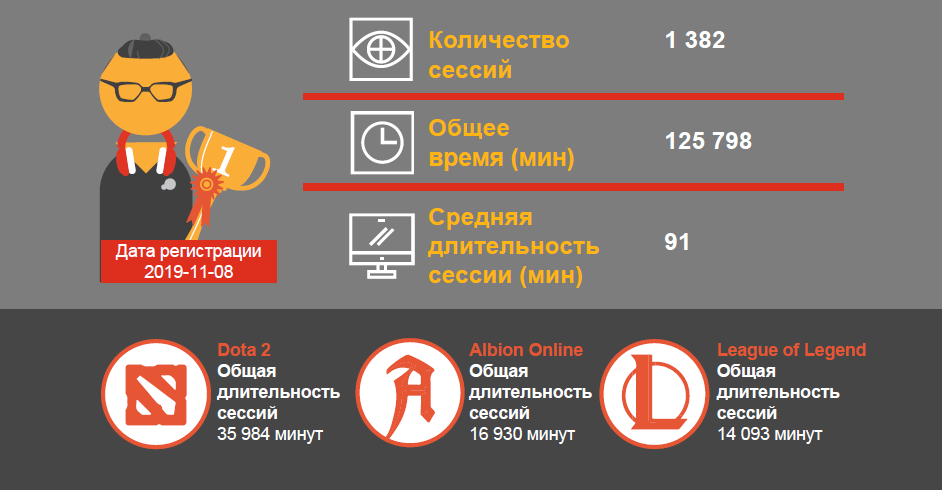
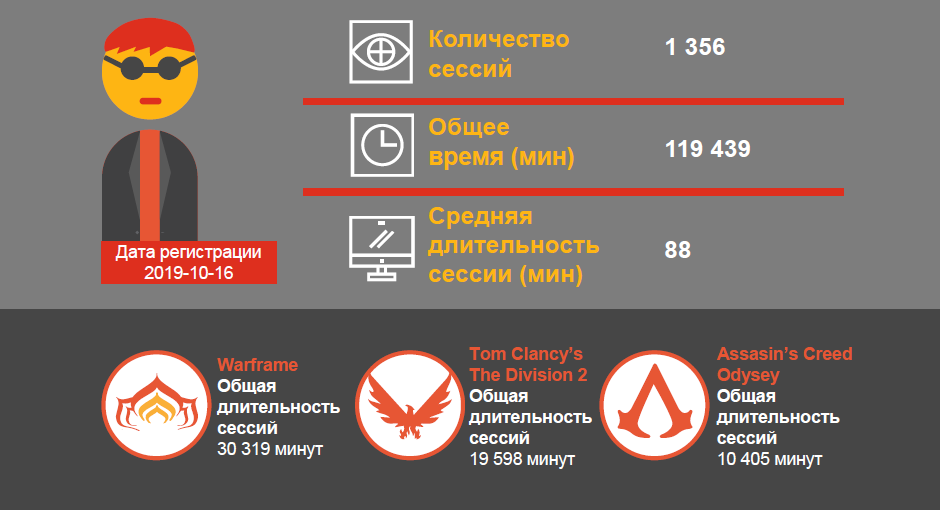
Platforms and type of internet connection
Distribution by platform type
More than 85% of the entire audience uses the service on personal computers with the Windows operating system. MacOS users are about 5% among GFN.RU clients. The number of mobile device users has almost doubled over the lifetime of the service, from 5% to 10%.
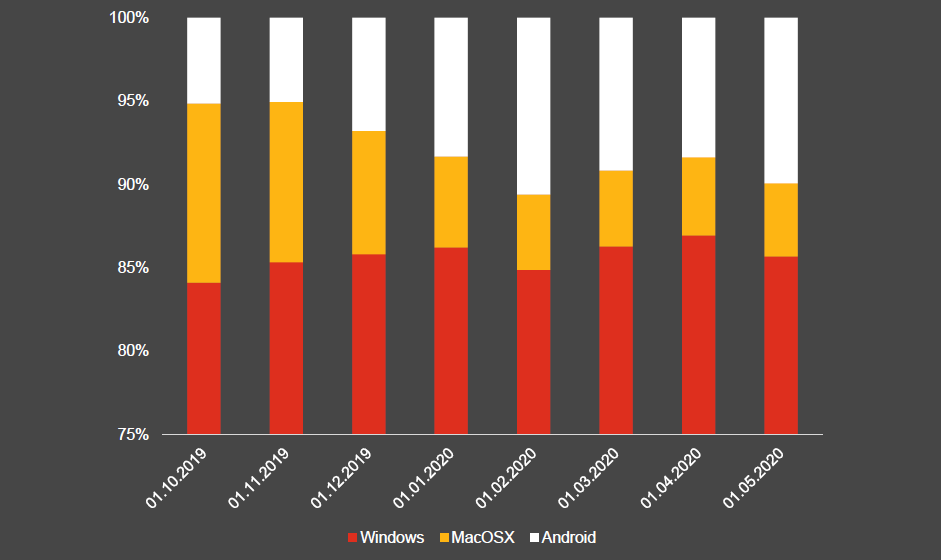
It should be noted that the gaming preferences of mobile users are radically different from those of PC users. Among smartphone users, Tekken7 is popular, and in SpellForce 3: Soul Harvest, the average duration of a gaming session is 2 times longer than a session on a PC.
MacOS has traditionally supported a small number of video games, but thanks to the opening of cloud gaming services, their number has increased significantly.
Distribution by internet connection type

The most popular way to connect to the Internet among cloud gaming users is to connect a computer directly via an Internet cable. This ensures the most stable signal and data transmission quality. Next comes the connection via Wi-Fi, which is preferred by more than a third of players.
Technical aspects of cloud gaming
On the user's side, the following factors are highlighted that affect the Internet signal:
- Frequency of Wi-FI. Today, two types of frequencies are widely used - 2.4 and 5 GHz. The first type works over fairly long distances, but uses the same frequency as Bluetooth, which can cause interference if the user uses, for example, wireless headphones or a keyboard. The second type of frequency is characterized by faster response and signal transmission rate, but works over short distances.
- . , — , .
- IoT . -, - . , Wi-Fi , -, .
Roundtrip - the speed of sending a signal from the client to the service server, then to the game servers and back to the user. On this route, the cloud gaming service is working to optimize connectivity in both directions, which can result in faster response times than directly from the user to the game server. The smaller the distance from the user to the server, the less the player notices the time between pressing a key or on the smartphone screen and the appearance of a response.
Typically in the gaming industry, a latency of 100–150 ms is considered acceptable for games, while the most comfortable value is 10–40 ms. For example, the latency from the wireless joystick to the on-screen display on the new Xbox X console is 8.3ms.
Roundtrip median values for different cities:
- Moscow - 6 ms;
- St. Petersburg - 14 ms;
- Kiev - 23 ms;
- Minsk - 24 ms;
- Yekaterinburg - 33 ms;
- Vladivostok - 115 ms;
- Sochi - 32 ms.
Packet Loss - packet loss that affects the quality of the picture on the user's screen. For example, if 20% of frames per second are lost, the image will jerk. The service software will try to stabilize the video stream, but its quality may decrease as a result.
Median Packet Loss values for different cities:
- Moscow - 0.0374;
- St. Petersburg - 0.0286;
- Kiev - 0.0788;
- Minsk - 0.0387;
- Yekaterinburg - 0.0254;
- Vladivostok - 0.0305;
- Sochi - 0.0599.
Bps - the number of transmitted bits per second (bit per second). Bps is one of the most important factors that directly affect image quality and signal acquisition speed.
Median Bps values for different cities:
- Moscow - 7670540.645;
- St. Petersburg - 7878417.23;
- Kiev - 6889558.41;
- Minsk - 6057146.76;
- Yekaterinburg - 6979723.14;
- Vladivostok - 5331858.21;
- Sochi - 7323782.63;
Although Moscow is the closest city to the servers, the median bps is not the best. This is due to the fact that the parameter depends not only on the cloud platform service itself, but also on the technical capabilities of the user: its provider, system settings and other factors that together affect the final value.
The ISP can also optimize the data transmission channel for the cloud gaming service in several ways:
- Setting up a peer-to-peer agreement. This method can positively affect the cost of Internet traffic, which is cheaper to pass using peering, and also improve the quality of the connection in general.
- QoS (quality of service). .
, GFN.RU
5G
The advent of the 5G network will enable mobile cloud gaming to fully evolve. At the moment, the share of gaming sessions via the mobile Internet is 2%, but with the advent of 5G, it should increase by at least 10 sub-points. The 5G network should make life easier not only for mobile gamers, but also for summer residents who launch our service via a modem.
In general, we see great prospects in mobile gaming: in the CIS, only our service allows you to launch new computer games from your phone. 5G technology makes it possible to turn your phone into a portable mobile station and run any computer game on it.
The emergence of new games on the service and competition for content
NVIDIA recently changed the details of its publisher and developer licensing agreement. It will now be significantly more difficult for publishers to retrieve their games from the GeForce NOW catalog.
At the time of this preparation, the GFN.RU library contains 561 games, but NVIDIA is constantly working to increase their number. Our subscribers receive weekly lists of a dozen new games.
Close cooperation on GFN with the Steam launcher, as well as Ubisoft, Epic games, CD Projekt and other major publishers allows you to add more games to the service on release day, add more than 10 games to the service every week, tightly integrate and create joint products, as well as promote them.
NVIDIA is constantly in talks with all the other major publishers to bring back and add their games to the service. Successful partnerships with other publishers should push them towards not abandoning new audiences that previously could not play, and thanks to GFN now have access to games.
NVIDIA is an important party in the creation of games, provides new technologies and has worked closely with all publishers in this area for many years, which should also ultimately affect the appearance of games in the service over time.
GeForce NOW Service Technologies
The GFN.RU service is constantly being improved and modernized. One of the technologies is RTX ray tracing, which allows you to provide previously unattainable levels of graphics in games. Lighting, reflections, shadows become natural and interactive. The photorealism we are accustomed to in movies is now also available in PC games. This technology is increasingly appearing in many new top games and can be fully enjoyed only on our service.
GFN.RU also supports DLSS (Deep Learning Super Sampling) technology... This method of anti-aliasing from NVIDIA using neural networks provides up to 2x performance gain (due to rendering fewer samples), improving the image quality using artificial intelligence. Powered by special CPU RTX tensor cores. Paired with tracing, it increases its performance. DLSS 2.0 allows you to get significantly higher fps, while cleaning the picture from artifacts, flickering and ghosting traces.
Technologies that ensure the quality of streaming, the cost-effectiveness of the service and allow, with a good connection, not to think about whether the game is running on a gaming PC or in the cloud, also play an important role.
All of these technologies are constantly evolving, improving and bringing new levels of capabilities. In the future, NVIDIA will be able to tell a lot and take GFN to the next level.
What is more important - the technical side of the service or a large library of games?
Both factors are important. Without a large library of games, the user will have nothing to do, even on the most technically advanced cloud service. At the same time, without the technical side, there is no point in a large library of games - if everything works every other time and in terrible graphics, then there is no value for the client in this service.
An ideal cloud service is a symbiosis of the technical side of the service and a large library of games.
Link to full material .